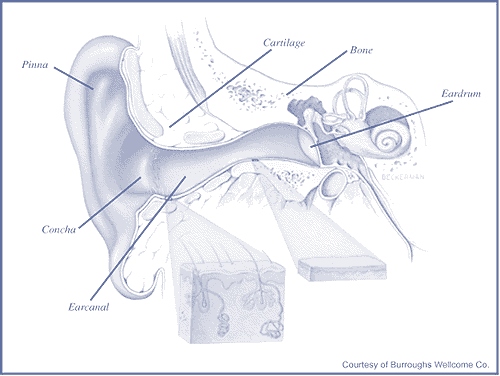CAOHC Newsletter: UPDATE
Cerumen Management
By Paul J. Brownson, MD, FACOEM, FAAFP
Representative of the American College of Occupational and Environmental
Medicine
Approximately 2-6% of the general population is afflicted by cerumen (earwax) impaction. Some of the known causes of cerumen impaction include abnormal external earcanal anatomy, occlusion by a hearing aid mold, associated dermatosis, and misguided attempts to remove wax via instrumentation1. Each week in the United States, it has been estimated that approximately 150,000 cerumen removals take place2. Otologic complications include failure to succeed in cerumen removal (which is the most common complication), pain, perforated eardrum, dizziness, bleeding and infection. This article provides some guidance on cerumen management for the OHC and the OHC’s professional supervisor, focused on simple measures the OHC may recommend to the individual prior to referral to an audiologist or physician. It is suggested that the OHC and the professional supervisor review cerumen management issues, and establish a plan or protocol for dealing with cerumen problems.
What is cerumen (earwax)?

Figure 1. Frontal section of the earcanal with magnification of the skin of the cartilaginous and osseous (bony) portions.
The outer ear is the funnel-like part of the ear you can see on the side of the head, plus the earcanal (the hole which leads down to the eardrum). The earcanal is shaped somewhat like an hourglass—narrowing part way down its length. The skin of the outer part of the canal has special glands, the ceruminous and sebaceous, that produce cerumen (earwax). Earwax functions to trap dust and sand particles to keep them from reaching the eardrum. Usually the wax accumulates a bit, then dries up and comes tumbling out of the ear, carrying sand and dust with it. Or it may slowly migrate to the outside where it is wiped off. Wax is not formed in the deep part of the earcanal near the eardrum, but only in the outer part of the canal.
Earwax is healthy in normal amounts and serves to coat the skin of the earcanal where it acts as a temporary water repellent. In addition to its water repellant effect, earwax may enhance resistance to infection of the earcanal, possibly related to the normally acid pH of earwax. In diabetics, earwax has been found to be less acid, and less protective1. The absence of earwax may result in dry, itchy ears. Most of the time the earcanals are self-cleaning. That is, there is a slow and orderly migration of earcanal skin from the eardrum to the ear opening. Old earwax is constantly being transported from the earcanal to the ear opening where it usually dries, flakes, and falls out3.
When an individual has wax blocked up against the eardrum, it is often because s/he has been probing their ear with such things as cotton-tipped applicators, bobby pins, or twisted napkin corners. Such objects only serve as ramrods to push the wax in deeper. Also, the skin of the earcanal and eardrum is very thin and fragile and is easily injured. Continual rubbing of the earcanal with a cotton-tipped applicator can abrade the skin and promote an infection. Individuals who wear hearing aids may also develop an accumulation of earwax because the hearing aid or earmold prevents the normal migration of the wax to the outside. Individuals who wear such devices should always have their health care provider inspect their earcanals for accumulation of cerumen.
When wax has accumulated so much that it blocks the earcanal (and reduces hearing), the individual’s audiologist or physician may have to wash it out, vacuum it with suction devices, or remove it with special instruments. The professional issues and techniques of earwax removal have been reviewed elsewhere4. The physician may prescribe ear drops that are designed to soften the wax. Available products include prescription only (such as Cerumenex) and over-the-counter products (OTC) such as Debrox, or Murine Ear Drops, Audiologist’s Choice (distributed through audiologists and same as Debrox or Murine), or straight hydrogen peroxide (3%)5. While the OTC drops are not as strong as the prescription earwax softeners, they are effective for many individuals, and are less likely to cause irritation or allergic reaction.
The
OHC’s role:
With appropriate training the OHC will recognize potential
cerumen impaction from the otoscopic exam. Under the professional
supervisor’s guidance and with careful review of contraindications,
the OHC may recommend use of ear drops to facilitate cerumen
removal. A history of perforation of the tympanic membrane,
the presence of myringotomy (PE) tubes, or cerumen impaction
in the only hearing ear are universal contraindications for
cerumen management by ear canal irrigation; such cases should
be referred to the individual’s physician or otolaryngologist6.
Relative contraindications which also suggest need for referral
to an employee’s physician or otolaryngologist include recent
earache, history of ear surgery, chronic otitis media, drainage,
dizziness, diabetes mellitus, AIDS, or any other condition that
would put the individual at risk4.
The OHC may wish to provide to the individual with suggested instructions for use of over-the-counter ear drops, as in the attached box.
|
|
References
1. Jabor MA, Amedee RG, Cerumen Impaction, J La State Med
Soc, VOL 149, 358-362 (October 1997). 2. Grossan M, Cerumen
Removal—Current Challenges, Ear, Nose & Throat Journal 77(7):
541-46, 544-46, 548 (1998). 3. Earwax…and what to do about it,
brochure of American Academy of Otolaryngology-Head and Neck
Surgery, Inc. (1995), One Prince Street, Alexandria, VA 22314-3357.
4. Wilson PL, Roeser RJ, Cerumen Management: Professional Issues
and Techniques, J Am Acad Audiol 8:421-430 (1997). 5. Freeman
RB, Impacted cerumen: How to safety remove earwax in an office
visit, Geratrics, 50(6): 52-53 (June 1995). 6. Davidson, TM,
Ambulatory Healthcare Pathways for Ear, Nose, and Throat Disorders:
Cerumen Extraction (Ear Wax), USCD Otolaryngology-Head and Neck
Surgery, February 4, 2000.


